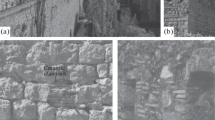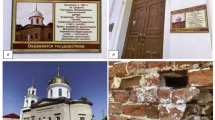The chemical and phase compositions of a ceramic material (plinth) aged more than 1,000 years that was used to construct the fortress wall were studied. Elemental analyses determined that the material had an increased carbon content of 9.50%, indicating that fuel was introduced into the raw material. This not only increased the porosity of the products but also contributed to uniform sintering of the ceramic shard and formed a glass phase up to 1000°C with an increased content of alkali oxides (R2O > 4%).




Similar content being viewed by others
References
V. Z. Abdrakhimov, “Effect of the phase composition on the durability of ceramic facing of the Shakhi-Zinda ensemble in Samarkand,” Steklo Keram., No. 3, 38 – 40 (2012).
V. Z. Abdrakhimov and E. S. Abdrakhimova, “Interrelation of the phase composition and durability of more than 800 year old brick for the example of the Kazan kremlin,” Steklo Keram., No. 2, 34 – 38 (2015).
V. Z. Abdrakhimov, “Relation between the phase composition and durability of ceramic brick older than 600 yr at the Ipat’evskii monastery,” Steklo Keram., No. 3, 29 – 32 (2013).
E. S. Abdrakhimova and V. Z. Abdrakhimov, “Chemical, phase compositions and porosity structure of the plinth brick of the White Tower (Greece) of age greater than 450 yr,” Steklo Keram., No. 4, 40 – 43 (2019).
V. F. Pavlov, Physicochemical Principles of Annealing Construction Ceramic Items [in Russian], Stroiizdat, 1977, 272 pp.
B. I. Vinogradov, Petrography of Synthetic Porous Fillers [in Russian], Izd. Literatury po Stroitel’stvu, Moscow, 1972, 135 pp.
G. I. Litvinova, V. P. Pirozhkova, and A. K. Petrov, Petrography of Nonmetallic Inclusions [in Russian], Metallurgiya, Moscow, 1972, 184 pp.
S. Zh. Saibulatov, S. T. Suleimenov, and A. V. Ralko, Ash-Ceramic Wall Materials [in Russian], Nauka, Alma-Ata, 1982, 292 pp.
V. I. Vereshchagin, A. E. Buruchenko, and V. K. Men’shikova, “Shrink-free facing ceramic material based on diopside raw material,” Sovrem. Probl. Nauki Obraz., No. 1, No. 1, 18 – 25 (2015).
E. S. Abdrakhimova and V. Z. Abdrakhimov, “Use of wollastonite in the production of ceramic articles,” Materialovedenie, No. 10, 47 – 52 (2004).
V. Z. Abdrakhimov, “Wollastonite in ceramic materials,” Ogneupory Tekh. Keram., No. 7, 41 – 47 (2006).
A. V. Abdrakhimov, I. V. Kovkov, and V. Z. Abdrakhimov, “Investigation by a regression method of the influence of wollastonite on the physicomechanical parameters of tile,” Izv. Vyssh. Uchebn. Zaved., Stroit., No. 8, 29 – 34 (2007).
V. P. Petrov, E. D. Belyankina, B. Z. Chistyakov, and V. V. Kozyrev, Wollastonite [in Russian], Nauka, Moscow, 1982, 112 pp.
V. F. Pavlov, “Transformation features of silica in clays,” Tr. NIIstroikeramiki, No. 38, 3 – 11 (1973).
D. S. Belyankin, B. V. Ivanov, and V. V. Lapin, Petrography of Industrial Rock [in Russian], AN SSSR, Moscow, 1952, 582 pp.
I. S. Kainarskii and N. G. Orlova, Physicochemical Principles of Ceramics [in Russian], Nauka, Moscow, 1956, 128 pp.
E. S. Abdrakhimova, A. V. Abdrakhimov, and V. Z. Abdrakhimov, “Polymorphic transformations of SiO2 in clayey materials of various chemical and mineralogical composition,” Materialovedenie, No. 7, 35 – 41 (2002).
V. Z. Abdrakhimov, V. V. Shevando, E. V. Vdovin, et al., “Polymorphic transformations of quartz in clays of various chemical and mineralogical composition,” Izv. Vyssh. Uchebn. Zaved., Stroit., No. 6, 40 – 47 (2007).
G. V. Kukolev, Chemistry of Silicon and Physical Chemistry of Silicates [in Russian], Vysshaya Shkola, Moscow, 1966, 250 pp.
Author information
Authors and Affiliations
Corresponding author
Additional information
Translated from Novye Ogneupory, No. 9, pp. 56 – 59, September, 2020.
Rights and permissions
About this article
Cite this article
Abdrakhimova, E.S., Abdrakhimov, V.Z. Relationship of Phase and Chemical Compositions of Durable Ceramic Material from the Fortification Wall of the City of Thessaloniki (Greece) Aged More Than 1,000 Years. Refract Ind Ceram 61, 536–539 (2021). https://doi.org/10.1007/s11148-021-00516-5
Received:
Published:
Issue Date:
DOI: https://doi.org/10.1007/s11148-021-00516-5




